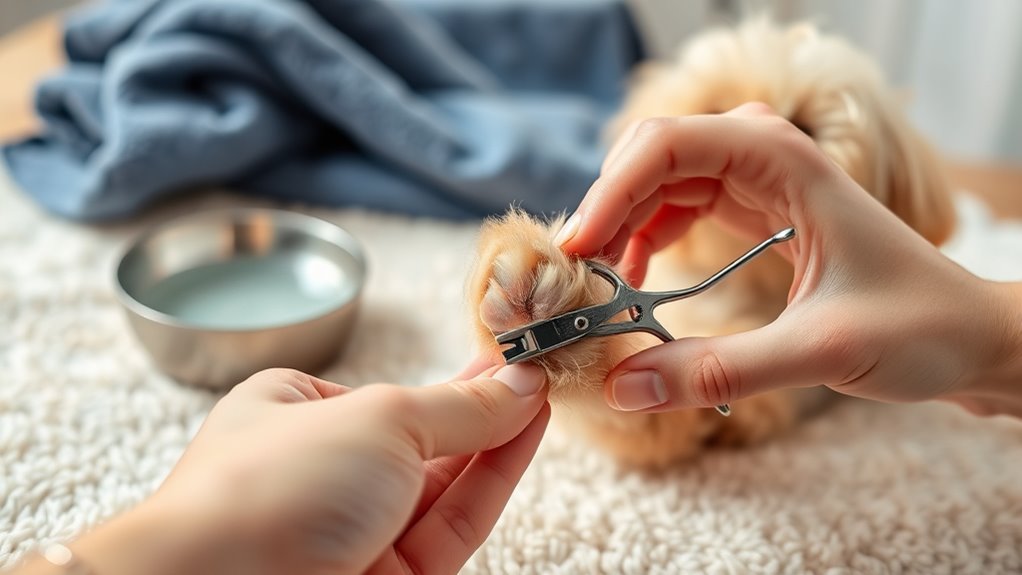To trim your dog’s nails safely, gather sharp, appropriate tools like nail clippers and styptic powder, then find a calm, well-lit space. Gently handle your dog’s paws to build comfort, and trim small amounts at a time to avoid the quick. If you accidentally cut into the quick and bleeding happens, apply pressure and styptic powder. Keep a routine, reward your dog, and always stay calm—more tips help make grooming easier and safer.
Key Takeaways
- Use sharp, appropriate nail clippers and avoid cutting into the quick to prevent bleeding and pain.
- Gradually introduce and handle your dog’s paws to build comfort and trust before trimming.
- Trim small amounts at a time, especially if inexperienced, and keep styptic powder nearby for accidental quick cuts.
- Offer treats, praise, and calming techniques to reinforce positive behavior during grooming sessions.
- Keep emergency supplies accessible and know how to apply pressure or styptic powder if bleeding occurs.
Gather the Right Tools and Prepare Your Space

Before you begin trimming your dog’s nails, it’s important to gather all the necessary tools and set up a calm, comfortable space. Make sure you have a good quality nail clipper or grinder, a nail file, and maybe styptic powder in case of accidental bleeding. Proper grooming session prep helps reduce your dog’s anxiety and makes the process smoother. Spend a few minutes calming your dog, perhaps with treats or gentle petting, to create a relaxed environment. When using nail file techniques, be gentle and steady, smoothing rough edges after clipping. Clear the area of distractions and choose a well-lit space so you can see what you’re doing. Preparing everything beforehand minimizes interruptions and keeps the grooming session efficient and stress-free for both of you. Additionally, understanding dog nail anatomy can help you trim safely without causing discomfort or injury.
Recognize Your Dog’s Nail Anatomy
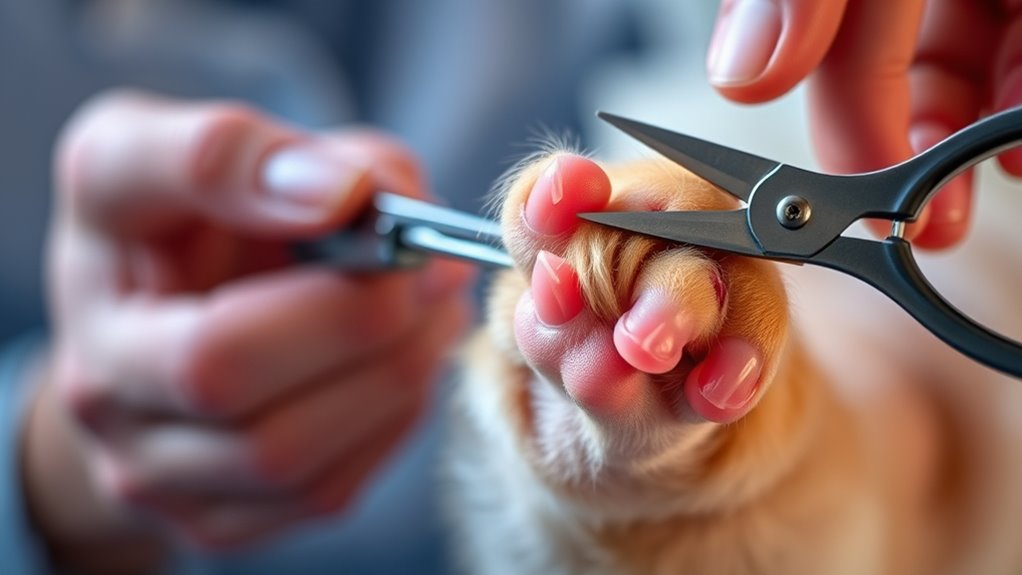
Understanding your dog’s nail anatomy helps make certain a safe trimming process. The nail anatomy includes the hard outer nail and the quick, a sensitive blood vessel inside. Knowing the dog paw structure is essential; the quick runs through the center of each nail and can be easily cut if you’re not careful. The outer part of the nail, or the claw, is what you trim, but avoid cutting too deep into the quick to prevent bleeding and pain. When examining your dog’s paws, look for the natural shape of the nails and the location of the quick. Recognizing these features helps you trim accurately and safely, reducing stress for both you and your dog. Understanding nail anatomy empowers you to trim confidently and prevent injury. Additionally, being familiar with installation guidelines can help you establish a proper routine for safe and effective nail trimming.
Choose the Best Time and Environment for Nail Trimming

Pick a time when your dog is relaxed and not overly energetic, like after a walk or play session. Choose a quiet, comfortable space free from distractions to help your dog stay calm. This approach makes nail trimming safer and less stressful for both of you. Incorporating calming techniques or familiar routines can further improve your dog’s behavioral response during grooming sessions.
Optimal Timing for Trimming
The best time to trim your dog’s nails is when they’re calm and relaxed, which makes the process easier and safer for both of you. Regular trimming aligns with their dog nail growth, preventing nails from becoming too long or uncomfortable. Pay attention to seasonal trimming needs; during winter, nails may grow faster due to less outdoor activity, requiring more frequent trims. Conversely, in warmer months, outdoor play naturally wears down nails, reducing the need for frequent grooming. Timing your sessions when your dog isn’t excited or anxious helps keep them relaxed, making nail trimming less stressful. By choosing the right moments, you ensure healthier nails and a more positive experience for your furry friend. Additionally, using portable grooming tools can make the process more efficient and comfortable.
Quiet, Comfortable Setting
Creating a quiet, comfortable environment is essential for a successful nail trimming session. A calm environment helps reduce your dog’s anxiety, making the process smoother. Choose a quiet room free from loud noises or distractions. Use a gentle approach, speaking softly and offering treats to reassure your dog. Timing is also important; pick a moment when your dog is relaxed, such as after exercise or playtime. Setting up everything beforehand minimizes stress. Here’s a helpful guide:
| Tip | Benefit |
|---|---|
| Trim in a familiar space | Comfort and familiarity boost cooperation |
| Use calming music | Creates a relaxing atmosphere |
| Keep sessions short | Prevents stress and fatigue |
| Maintain gentle handling | Builds trust with your dog |
| Have treats ready | Rewards good behavior and cooperation |
Being aware of signs of stress can help you recognize when your dog is becoming overwhelmed during the process.
Get Your Dog Comfortable With Handling Their Paws
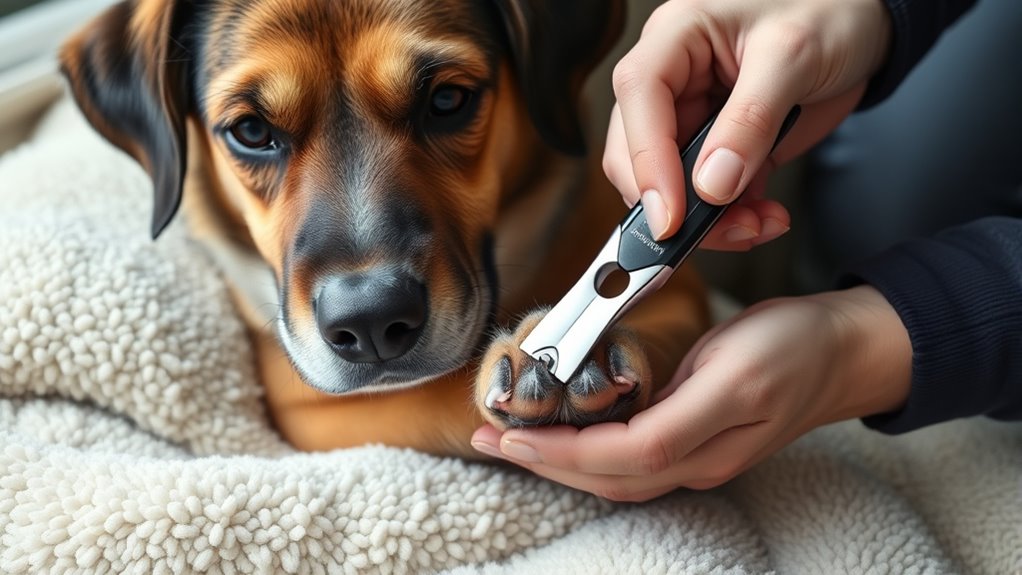
Getting your dog comfortable with handling their paws is an essential first step before trimming their nails. Start by gently touching their paws during calm moments, paying attention to paw pad sensitivity. Some dogs are more sensitive around their paw pads, so go slowly and watch for signs of discomfort. Familiarize your dog with their nail growth patterns by gently touching and lifting their paws regularly. Use positive reinforcement, like praise or treats, to create a positive association. Gradually increase the duration and firmness of your touch as your dog becomes more relaxed. This process helps your dog trust you and reduces anxiety during trimming. Understanding color accuracy in home cinema projectors can also help you select the right environment for your viewing area. Patience is key—building comfort takes time but makes nail trimming safer and easier for both of you.
Proper Technique for Cutting Your Dog’s Nails
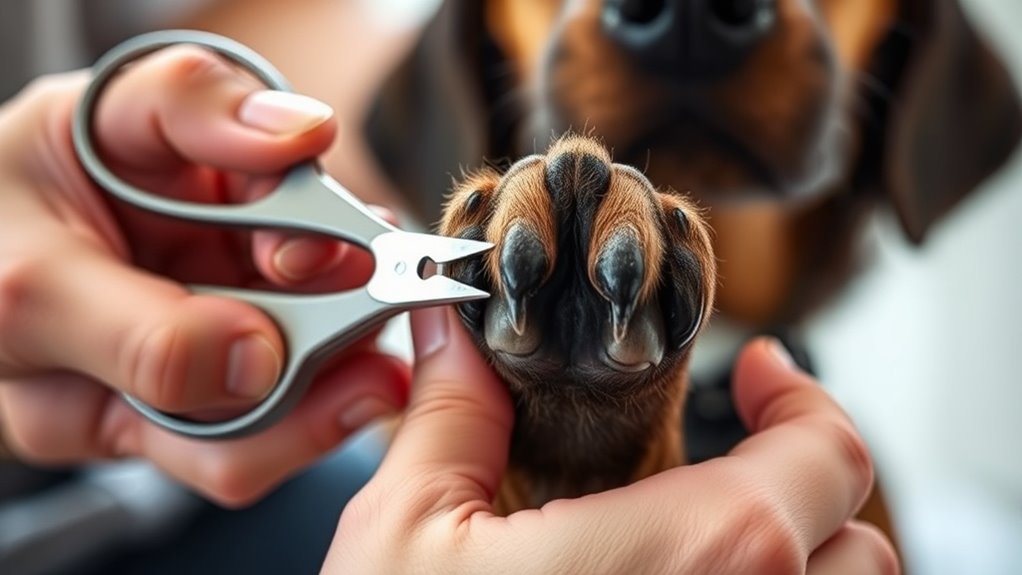
To trim your dog’s nails safely, make sure you’re using proper nail clippers designed for pets. Be careful to avoid the quick, which can cause bleeding and pain if cut. With the right tools and technique, you can keep your dog comfortable and injury-free. Additionally, using appropriate trimming techniques can help prevent stress and make the process smoother for both you and your dog.
Use Proper Nail Clippers
Using the right nail clippers is essential for trimming your dog’s nails safely and effectively. There are various nail clipper types, such as guillotine, scissors-style, and electric grinders. Choose one that feels comfortable in your hand and suits your dog’s nail size. Safety precautions include ensuring the clipper is sharp to prevent crushing the nail and avoiding excessive pressure. Using the wrong type or dull tools can cause pain or injury. Here’s a quick comparison:
| Nail Clipper Type | Best For |
|---|---|
| Guillotine | Small to medium nails |
| Scissors-style | Larger, thicker nails |
| Electric grinders | Gentle, regular maintenance |
Select the right tool and follow safety precautions for a smooth, safe trimming experience. Incorporating proper technique can also greatly reduce stress for both you and your dog.
Avoid Quick and Bleeding
Even with careful trimming, it’s easy to accidentally cut into the quick—the sensitive area containing blood vessels and nerves—causing bleeding and pain. To avoid quick nail trimming and prevent nerve damage, follow these tips:
- Use sharp, proper nail clippers to make clean cuts.
- Trim small amounts at a time, especially if you’re new to quick nail trimming.
- Watch for the pinkish quick; avoid cutting into it to prevent bleeding.
- Have styptic powder nearby in case you accidentally nick the quick.
- Being familiar with local regulations and guidelines can help ensure your grooming practices are safe and appropriate for your dog.
Handling Bleeding and Nail Emergencies
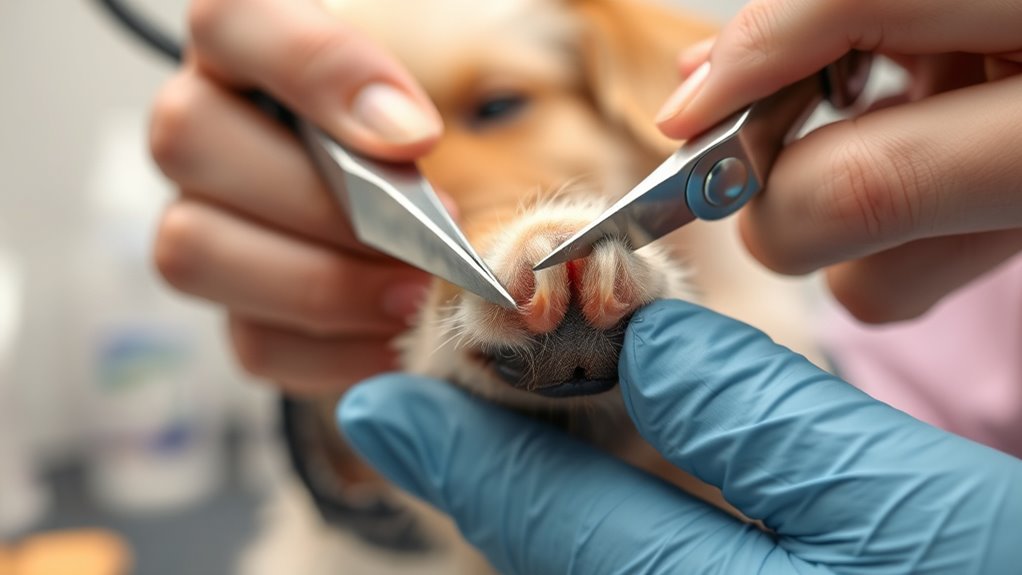
When a dog’s nail starts bleeding unexpectedly, quick and calm action can prevent further injury or stress. First, stay composed and act promptly with bleeding management. Apply gentle pressure with a clean cloth or sterile gauze directly on the nail to slow or stop the bleeding. If the bleeding persists, consider using a styptic powder or pencil, which helps constrict blood vessels and speed up clotting. Always be prepared for emergencies by keeping these supplies accessible. Remember, your emergency preparedness can make a difference in minimizing pain and preventing infection. If bleeding continues despite these efforts or if your dog shows signs of distress, seek veterinary assistance immediately. Staying calm and prepared helps ensure your dog recovers comfortably and safely.
Reinforce Positive Associations and Rewards
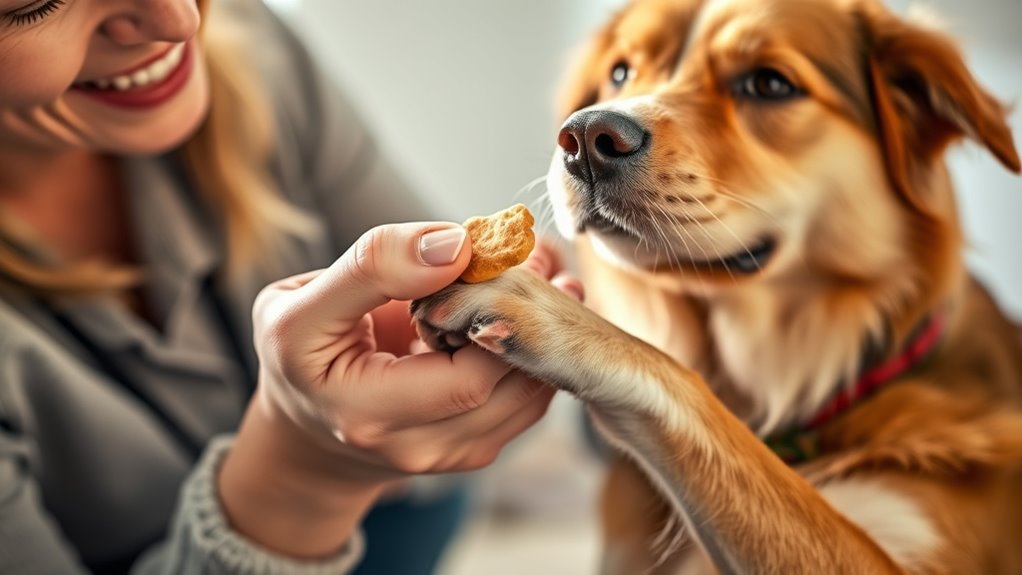
Have you ever noticed how your dog responds better to grooming when they associate the experience with something positive? Reinforcing positive associations and rewards can make nail trimming less stressful. To treat anxiety and encourage cooperation, try these strategies:
- Offer treats before, during, and after each nail trim to create a positive link.
- Use praise and gentle petting to reward calm behavior.
- Keep sessions short and frequent, ending on a positive note.
- Gradually introduce your dog to the tools, offering treats to build comfort.
- Incorporate calming techniques, such as calming music or aromatherapy, to reduce stress during grooming sessions.
Establish a Regular Nail Maintenance Routine
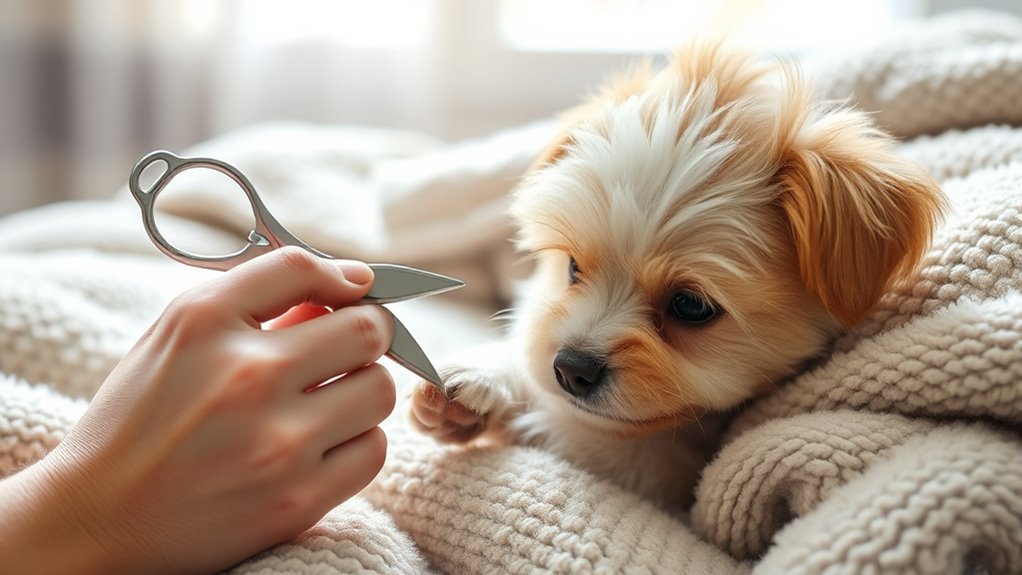
Establishing a regular nail maintenance routine is essential for keeping your dog’s nails healthy and preventing discomfort or injury. Consistency helps maintain ideal nail health and reduces the risk of overgrowth or cracking. Incorporate nail trims into your dog’s grooming schedule—weekly or bi-weekly, depending on their activity level and nail growth. Doing so ensures that nails stay at a comfortable length and prevents them from causing pain or affecting your dog’s gait. Regular maintenance also makes trimming easier over time, as your dog becomes accustomed to the process. Use positive reinforcement to create a calm, stress-free experience. Proper nail trimming techniques are vital to avoid injury and ensure the process is safe for your pet. By sticking to a routine, you’ll keep your dog comfortable, healthy, and happy, while reducing the likelihood of needing more intensive grooming or veterinary intervention later.
Frequently Asked Questions
How Often Should I Trim My Dog’s Nails?
You should trim your dog’s nails every 3 to 4 weeks to maintain nail health and prevent discomfort. Regular trimming keeps nails from becoming too long, which can cause pain or walking issues. Monitor your dog’s nails closely, and adjust the trimming frequency if needed—longer nails may require more frequent care. Consistent trimming helps keep your dog comfortable and healthy, avoiding the risks associated with overgrown nails.
Can I Use Human Nail Clippers on My Dog?
You shouldn’t use human nail clippers for dog grooming because they’re not designed for your pet’s nails. Dog grooming requires specific nail trimming tools that safely accommodate different nail thicknesses and shapes. Human clippers can cause splintering, pain, or injury. Invest in proper dog nail trimming tools to make the process safer and easier, ensuring your dog’s comfort and health during each grooming session.
What Signs Indicate My Dog Is Stressed During Trimming?
If your dog shows signs of stress during trimming, you’ll notice increased dog anxiety, such as panting, trembling, or trying to pull away. You might see signs of trimming discomfort, like yelping or growling. Keep an eye on their body language—stiffness or avoiding eye contact. Recognizing these signs helps you pause or slow down, making the process easier and less stressful for your furry friend.
Is It Safe to Trim Nails if My Dog Has Health Issues?
Sure, trimming your dog’s nails with health issues might seem like a walk in the park—until you realize it’s a tightrope walk over a pit of vipers. You should definitely consult your vet first, considering dog health considerations. They’ll tell you if it’s safe or if you need extra precautions. Never guess with health issues; expert advice guarantees you don’t turn a simple trim into a veterinary emergency.
How Do I Prevent My Dog From Scratching After Trimming?
After trimming your dog’s nails, prevent scratching by applying a pet-safe paw pad balm to soothe any irritation. Keep your dog’s paws clean, especially the paw pads, to avoid infection. Use gentle pressure with your nail trimming tools, and reward your dog with treats for good behavior. Regularly check and trim nails to reduce scratching, and provide soft bedding to minimize discomfort. This helps keep their paws healthy and less prone to scratching.
Conclusion
Remember, a well-trimmed dog’s nails not only look good but also keep your furry friend comfortable and healthy. Take your time, stay patient, and create positive experiences—after all, practice makes perfect. With gentle handling and the right tools, you’ll turn nail trimming into a safe, stress-free routine. As the saying goes, “A stitch in time saves nine,” so stay consistent and keep your pup’s paws happy and healthy.
